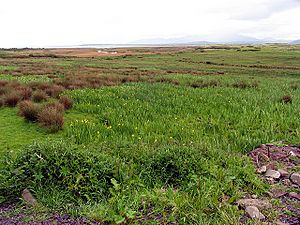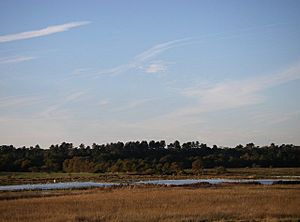Dingle Marshes facts for kids
Quick facts for kids Dingle Marshes |
|
|---|---|
 |
|
| Type | Nature reserve |
| Location | Dunwich, Suffolk |
| OS grid | TM479708 |
| Area | 93 hectares |
| Managed by | Suffolk Wildlife Trust |
Dingle Marshes is a special wildlife reserve on the coast of Suffolk, England. It covers about 93 hectares (that's like 230 football fields!). This amazing place is found between the villages of Dunwich and Walberswick, not too far from Southwold.
The marshes are part of the bigger Suffolk Coast National Nature Reserve. This means it's a really important area for nature. The reserve is looked after by two main groups: the RSPB and the Suffolk Wildlife Trust. They work together to protect the animals and plants that live here.
Dingle Marshes is known around the world for its wildlife. It's a key home for the super rare starlet sea anemone. It's also a vital spot for birds like bitterns and marsh harriers in the UK. This special place was bought in 1999 to make sure it stays safe for future generations.
Contents
What is the Landscape Like?
The Dingle Marshes are part of a wide, open coastal area in Suffolk. There aren't many trees here, which makes it feel very open.
Long ago, before 1587, people drained the marshes. They used the land for cows to graze. But over time, especially after the mid-1900s, the land was allowed to flood again. Now it has gone back to being a natural fen, which is a type of wetland.
What Animals Live Here?
The marshes have a mix of different watery homes. There are both coastal areas and freshwater wetlands. You can even find pools with salty water, called brackish pools.
These different habitats are perfect for many animals. Birds like bitterns, marsh harriers, and bearded tits come here to have their babies. You might also spot mammals like European otters and water voles.
In winter, many birds visit Dingle Marshes. These include pied avocets, white-fronted geese, northern lapwings, and redshanks.
The reserve is super important for the starlet sea anemone. This is the rarest sea anemone in Britain!
On the side away from the sea, the marshes are next to heathland and forests. Closer to the sea, there's a bank made of shingle (small stones) with plants growing on it. Little terns, which are small seabirds, often build their nests along this shingle bank.
How Does Flooding Affect the Marshes?
The marshes have been affected by flooding from the sea several times. Big floods happened in 2003, 2006, and 2007.
In 2006 and 2007, the shingle bank that protects the marshes broke open. This caused worry that the freshwater areas, where birds like bitterns breed, could be damaged by the salty seawater.
To help protect the reserve, the Environment Agency built new flood defences. They did emergency work after the 2006 flood. Then, in 2012, they made these defences even stronger to keep the marshes safe.
What Can Visitors Do?
You can visit Dingle Marshes from the south, near Dunwich beach. There's a car park and other things you might need, looked after by East Suffolk council.
There's a circular path you can walk around the marshes. It's a great way to explore the area. The RSPB also has a hide (a special hut) where you can watch the birds without disturbing them.


